- Scientific name: Platanthera macrophylla
- Species of Greatest Conservation Need (MA State Wildlife Action Plan)
- Threatened (MA Endangered Species Act)
Description
Large round-leaved orchid, Platanthera macrophylla, is a perennial plant of the orchid family (orchidaceae) found in moist woods or bogs. It is one of three species of Platanthera orchids in this genus that have paired round, glossy basal leaves and, without the flowers, can be very difficult to determine which species. This includes large round-leaved orchid (P. macrophylla), round-leaved orchid (P. orbiculata) and Hooker’s orchid (P. hookeri). All three are glabrous (have no hairs) plants and may occur in similar habitats. Unfortunately, these round-leaved orchids do not always flower each year, complicating their identification. However, all three species are now listed and protected under the Massachusetts Endangered Species Act. The two “round-leaved orchids” also have similar flowers that need floral parts to be measured carefully to determine which species has been observed. Hooker’s orchid has distinctive flowers that cannot be confused with the two round-leaved orchids.
Large round-leaved orchid is most similar to the slightly smaller round-leaved orchid (P. orbiculata). Both are perennial wildflowers and have been variously lumped as one species with two varieties and as two separate species. In large round-leaved orchid, the two large opposite basal leaves which lie on the ground, range in size from 7-24 cm (2.8-9.4 in) by 5-19 cm (2.0-7.5 in), while those of round-leaved orchid are 5-10 cm (3-4 in.) The flowers of large round-leaved orchid are in a raceme up to 50 cm (19.7 in) tall and the petal and sepal color ranges from white to greenish-brown. It has a linear, elongated labellum (lower petal) with an unusually long nectar spur, mostly 28-46 mm (1.1-1.8 in) in length, which extends out behind the flower, and pollinarium are 4.7-6.8 mm (0.19-2.7 in) in length. Haines 2011 gives this description of measurements to determine large round-leaved orchid, the “spur length plus twice the pollinarium length [is] equal to or greater than 38.” If those measurements are less than 38, the plant is the similar looking round-leaved orchid, P. orbiculata. The flowering scapes have 1 to 6 small bracts on the flowering stem. The plants can produce up to 20 showy flowers.
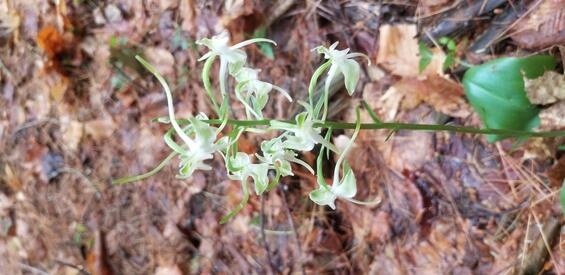
Platanthera macrophylla in flower.
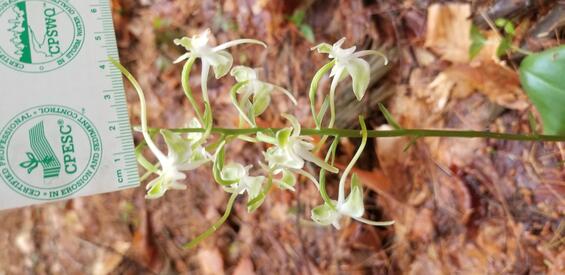
Platanthera macrophylla spur being measured.
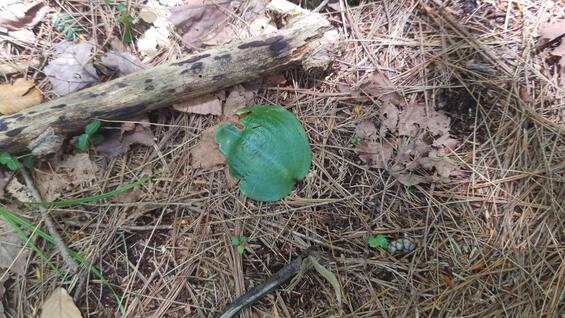
Platanthera macrophylla young plant with only 1 leaf.
Life cycle and behavior
Large round-leaved orchid paired leaves will emerge during May. The flowering stalk will push up soon after and it will be in bloom from the last week of June through July. Large round-leaved orchid is pollinated by hawk moths with long tongues to reach the nectar deep within the spur. The pollinators will have at least one pollinium stick to them to be carried to and deposited at another flower. The capsules are held upright and will be mature by fall, releasing thousands of wind-distributed seeds less than 2 mm (0.08 in) in size. Only a few seeds are likely to land in an appropriate habitat, then they will need to be infected by acceptable mycorrhizal fungi before they can germinate and form an underground protocorm. Cleavitt et al. 2016 describe 5 life stages:
- “underground germinant/protocorm;
- above-ground juvenile with a single linear leaf (at least 2:1 in length–width);
- an immature stage with a single round leaf;
- vegetative adult with two rounded leaves; and
- flowering adult with two rounded basal leaves and a raceme.”
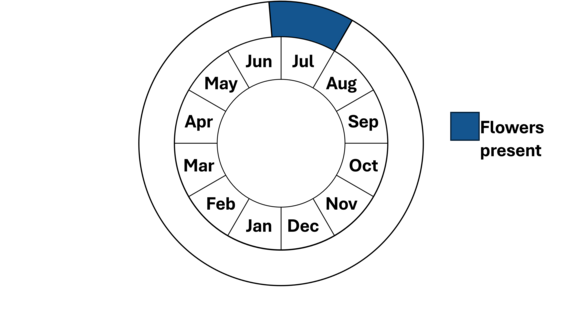
Distribution in Massachusetts.1999-2024. Based on records in the Natural Heritage Database
Population status
In Massachusetts, large round-leaved orchid is listed under the Massachusetts Endangered Species Act as Threatened. All listed species are protected from killing, collecting, possessing, or sale and from activities that would destroy habitat and thus directly or indirectly cause mortality or disrupt critical behaviors. There are currently 14 occurrences in the state verified within the past 25 years found in Berkshire, Franklin, Hampden, and Hampshire Counties. There are 2 historical occurrences with locational data that have not been relocated. The known populations are typically small with only 1 to 10 plants observed.
Distribution and abundance
This species occurs only in northeastern North America from Newfoundland to Ontario, south to West Virginia and Maryland with disjunct population in North Carolina. It is considered imperiled in the Canadian provinces where it occurs, as well as critically imperiled in Massachusetts, Vermont and Pennsylvania. It has apparently declined over much of its range and is possibly extirpated from Connecticut and Rhode Island. It has not been assessed in Maine or New Hampshire.
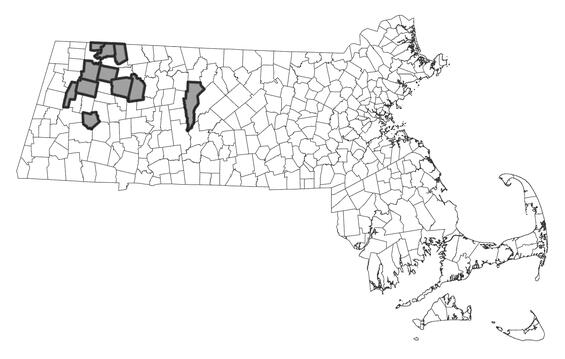
Distribution in Massachusetts.1999-2024. Based on records in the Natural Heritage Database
Habitat
This is a species of forests, often near small streams or in marginal wetlands. It prefers soils with a slightly higher pH or higher minerals and is mostly found west of the Connecticut River. It may be found in forested swamps and wetlands, including rich mesic to wet coniferous and deciduous forests with no or few understory species. Mixed hardwoods make up the canopy and partridgeberry (Mitchella repens), goldthread (Coptis trifolia), wild sarsaparilla (Aralia nudicaulis), starflower (Lysimachia borealis), cucumber root (Medeola virginiana), southern beech fern (Phegopteris hexagonoptera), and bunch berry (Cornus canadense).
Healthy habitats are vital for supporting native wildlife and plants. Explore habitats and learn about conservation and restoration in Massachusetts.
Platanthera macrophylla habitat.
Threats
The exact threats to large round-leaved orchid and not fully known. However, known or putative causes of decline include, but are not limited to, deer herbivory (Knapp and Wiegand 2014) particularly for large showy orchids, earthworms (McCormick et al. 2A23), lack of disturbance (Sheviak 1990), nitrogen deposition (Figura et aL 2A20), and canopy closure (Brumback et al. 2011, Whigham et al.202l), all of which affect orchids in Massachusetts. Another specific threat includes climate change (Staudinger et al. 2024); both warmer temperatures and changes in rainfall may negatively affect this species. Finally, changes to the mycorrhizal community on which this species depends are another threat.
Conservation
Survey and monitoring
As with all rare plant species, regular monitoring is important to assess the health of the populations. Orchids can be particularly difficult to monitor as they bloom, or even show on the surface, only when the conditions are “right.” The population may have apparent swings in numbers observed from one year to the next, even though the numbers of plants may be relatively stable. If large round-leaved orchid is not observed one year, it does not mean that the plant is not present. The best time to survey for this species is when it is in bloom from late June through July. It is important to survey when flowers are present so that the species may be confirmed. Each plant is a separate genet.
Management
The management needs of large round-leaved orchid are not known. As a woodland species, some shade is probably needed, however too much is thought to be a problem. As with many orchids, some disturbance is needed. Protection from deer and other animal browse is likely to be needed and may include fencing of some type.
Research needs
More research is needed to determine methods to identify large round-leaved orchid and its cogeners in the same habitat when flowers are not present. Genetic studies have not been completed on these orchids and may be helpful in determining their relatedness. The specific mycorrhizae needed for germination is unknown, and it is not known if an association is life-long for this orchid.
References
Berry, EJ and NL Cleavitt QAZD Population dynamics and comparative demographics in sympatric populations of the round-leaved orchids Platanthera mocropltylla and P. orbiculata. Population Ecology. 63 (4),274-289.
Brumback WE, Cairns S, Sperduto MB, Fyler CW (2011) Response of an Isotria medeoloides Population to Canopy Thinning. Northeastern Naturalist 18:185–196.
Cleavitt, Natalie L., Eric Berry, Jill Hautaniemi and Timothy J. Fahey. Life stages, demographic rates and leaf damage for the round-leaved orchids, Platanthera orbiculata (Pursh.) Lindley and P. macrophylla (Goldie) P.M. Brown in a northern hardwood forest in New Hampshire, USA. Botany 95: 61-71 (2016) dx.doi.org/10.1139/cjb-2016-0164
Figura T, Weiser M, Ponert J (2020) orchid seed sensitivity to nitrate reflects habitat preferences and soil nitrate content. Plant Biology 22:21–29.
Frost, Karro. 2023. Species listing proposal for Platanthera macrophylla . Massachusetts Natural Heritage & Endangered Species. Massachusetts Division of Fisheries and Wildlife, Westborough, MA.
Gleason, H.A., and A. Cronquist. 1991. Manual of Vascular Plants of Northeastern United States and Adjacent Canada, Second Edition. The New York Botanical Garden, Bronx, New York.
Haines, A. 2011. Flora Novae Angliae – a Manual for the Identification of Native and Naturalized Higher Vascular Plants of New England. New England Wildflower Society, Yale Univ. Press, New Haven, CT.
Knapp WM, Wiegand R (2014) orchid (orchidaceae) decline in the Catoctin Mountains, Frederick County, Maryland as documented by a long-term dataset. Biodivers Conserv 23:1965–1976.
McCormick MK, Parker KL, Szlavecz K, Whigham DF (2013) Native and exotic earthworms affect orchid seed loss. AoB PLANTS 5:plt018. https://doi.org/10.1093/aobpla/plt018
Native Plant Trust. 2014. NORM Phenology Information.
NatureServe. 2025. NatureServe Network Biodiversity Location Data accessed through NatureServe Explorer [web application]. NatureServe, Arlington, Virginia. Available https://explorer.natureserve.org/. Accessed: 3/25/2025.
POWO (2025). Plants of the World Online. Facilitated by the Royal Botanic Gardens, Kew. Published on the Internet; Accessed: 3/25/2025.
Sheviak CJ (1990) Biological considerations in the management of temperate terrestrial orchid habitats. New York State Museum Bulletin 471:194–196
Sheviak, C.J. 2003. Platanthera in Flora of North America. Editorial Committee, editors. Flora of North America, Volume 26 Page 555. Oxford University Press, New York, New York.
Smith, Welby R. 2012. Native orchids of Minnesota. University of Minnesota Press, Minneapolis MN.
Staudinger, M.D., A.V. Karmalkar, K. Terwilliger, K. Burgio, A. Lubeck, H. Higgins, T. Rice, T.L. Morelli, A. D'Amato. 2024. A regional synthesis of climate data to inform the 2025 State Wildlife Action Plans in the Northeast U.S. DOI Northeast Climate Adaptation Science Center Cooperator Report. 406 p.
Whigham D, McCormick M, Brooks H, et al (2021) Isotria medeoloides, a North American Threatened orchid: Fungal Abundance May Be as Important as Light in Species Management. Plants 10:1924.
Contact
| Date published: | May 2, 2025 |
|---|